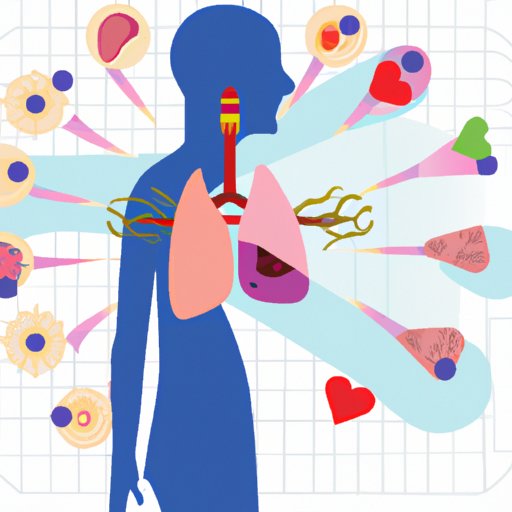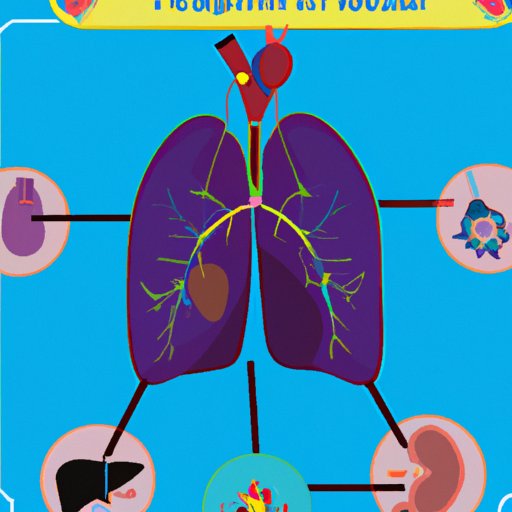Introduction
The heart is one of the most important organs in the body, responsible for pumping oxygenated blood throughout our circulatory system. It’s a highly complex organ that requires a great deal of knowledge and skill to understand and treat. In this article, we’ll explore the anatomy and function of the heart, examine cardiac pathology and medications, investigate the relationship between the heart and lungs, and look at the role of genetics in heart health.
Anatomy of the Heart: Exploring the Structural and Functional Aspects
The human heart is a four-chambered organ located in the chest, behind the breastbone. The two upper chambers, the left and right atria, receive deoxygenated blood from the body and oxygenated blood from the lungs. The two lower chambers, the left and right ventricles, pump the oxygenated blood to the body and the deoxygenated blood back to the lungs. The heart also has four valves—the tricuspid valve, the pulmonary valve, the mitral valve, and the aortic valve—which regulate the flow of blood through the chambers.
As explained by Dr. Bruce Rosen, Professor of Radiology at Harvard Medical School, “The heart is a muscular organ that pumps blood to all parts of the body. It beats about 100,000 times a day, pumping about 2,000 gallons of blood.”
The heart’s contractions are powered by electrical signals that travel through the heart muscle. This process begins in the sinoatrial (SA) node, which is a small cluster of cells in the right atrium known as the pacemaker of the heart. The SA node generates electrical impulses that cause the atria to contract and pump blood into the ventricles. The electrical signal then travels through the atrioventricular (AV) node, which slows down the signal before it passes through the bundle of His and the Purkinje fibers, causing the ventricles to contract and pump blood out of the heart.
Understanding Cardiac Pathology to Enhance Diagnosis and Treatment
Cardiac disease is one of the leading causes of death worldwide, according to a 2018 study published in the journal Circulation. Common types of heart disease include coronary artery disease, congestive heart failure, valvular heart disease, and arrhythmia. Symptoms can vary depending on the type of heart disease, but may include chest pain, shortness of breath, fatigue, palpitations, and dizziness.
To diagnose and evaluate heart health, doctors use a variety of tests including echocardiograms, stress tests, electrocardiograms (ECGs), and cardiac catheterization. Treatments for heart disease range from lifestyle modifications such as diet and exercise, to medication and surgery.

Examining the Role of Cardiac Medications in Maintaining a Healthy Heart
Cardiac medications are an important part of treating and managing heart conditions. These medications can help reduce symptoms, decrease the risk of complications, and improve overall heart health. Common types of cardiac medications include beta blockers, calcium channel blockers, ACE inhibitors, and diuretics.
According to Dr. Andrew Kao, Chief of Cardiology at the Cleveland Clinic, “Cardiac medications are an essential part of managing heart health. They can help reduce symptoms, reduce the risk of complications, and improve overall heart health.”
While these medications can be beneficial, it’s important to be aware of the potential risks associated with them. Side effects can include dizziness, nausea, headaches, and fatigue. It’s also important to talk to your doctor about any other medications you’re taking, as some drugs can interact with each other and cause serious side effects.

Exploring the Complex Interaction Between the Heart and Lungs
The heart and lungs are closely intertwined and depend on each other to function properly. The lungs provide oxygen to the heart, while the heart pumps oxygenated blood throughout the body. When the lungs are unable to adequately supply oxygen, the heart must work harder to make up the difference, which can lead to heart failure.
In addition, certain types of lung diseases, such as chronic obstructive pulmonary disease (COPD), can lead to an increased risk of cardiovascular disease. According to a 2017 study published in the journal Pulmonary Medicine, COPD patients have an increased risk of developing heart disease due to reduced oxygen levels in the blood and inflammation of the arteries.

Investigating the Impact of Genetics on Heart Health
Genetics play an important role in heart health. Research shows that certain genetic variants can increase the risk of developing heart disease, while others can protect against it. For example, a 2016 study published in the journal Nature Genetics found that a variant of the APOA5 gene was associated with an increased risk of coronary artery disease.
Genetic testing is a valuable tool for evaluating heart risk, as it can help identify individuals who have an increased risk of developing heart disease. Genetic testing can also help determine the best course of treatment for those who already have heart disease.
Conclusion
The heart is a complex organ that requires a great deal of knowledge and skill to understand and treat. In this article, we explored the anatomy and function of the heart, examined cardiac pathology and medications, investigated the relationship between the heart and lungs, and looked at the role of genetics in heart health. We also discussed diagnostic tests and treatments for common types of heart disease. By understanding the structure and function of the heart, physicians can better diagnose and treat heart disease.
For further reading, we recommend the following books: The Harvard Medical School Guide to a Good Heart by Kenneth A. Ellenbogen, Cardiology in Primary Care by Gerald Fletcher, and Genetics and Cardiovascular Disease by Barry London.
(Note: Is this article not meeting your expectations? Do you have knowledge or insights to share? Unlock new opportunities and expand your reach by joining our authors team. Click Registration to join us and share your expertise with our readers.)
